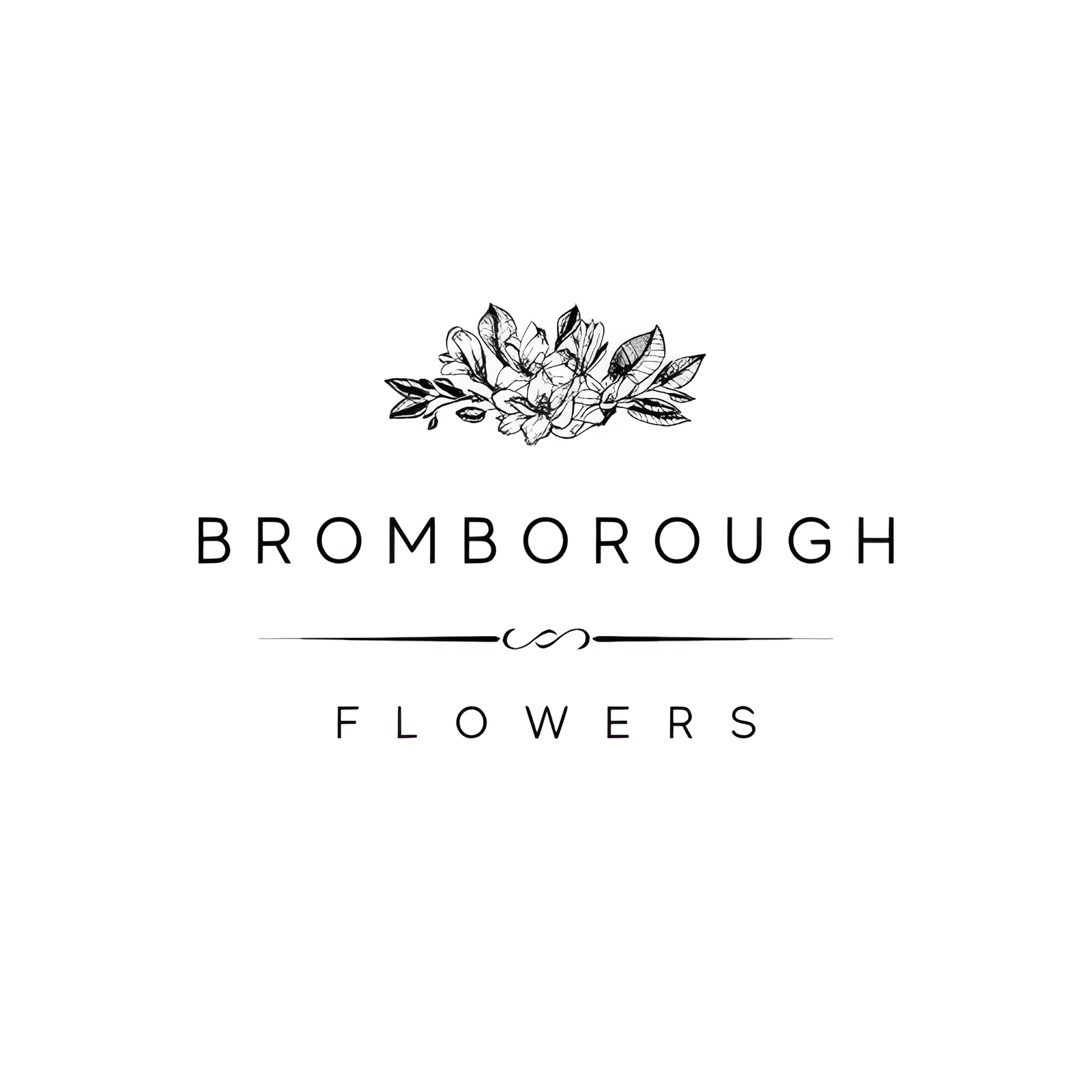The charm of foxglove flowers in wedding arrangements lies not only in their striking bell-shaped blooms but also in their remarkable versatility and color range. Known scientifically as Digitalis purpurea, these flowers originate from Europe and thrive in both partial shade and full sun. With hues spanning from soft pinks to vibrant peachy-oranges, foxgloves can enhance the sophistication of any bouquet or centerpiece. The vase life of 5-7 days ensures they remain fresh throughout your event. But what makes foxglove truly unique in wedding floral design? Discover the cultural significance and ideal pairings that elevate foxgloves to a favored choice for bridal aesthetics.
Flower Overview
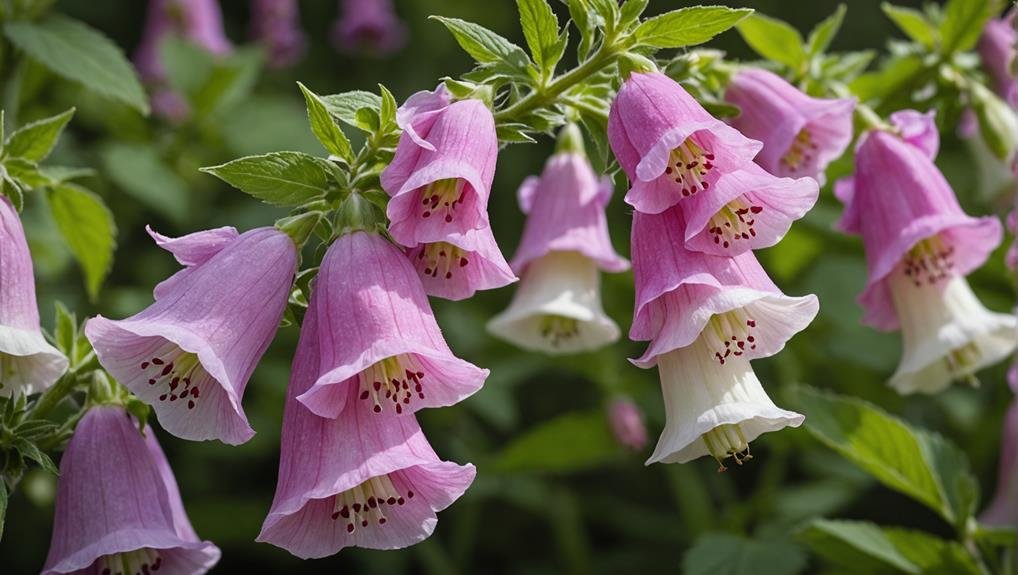
Foxglove, with its large bell-shaped blooms in hues of pink and peachy-orange, is an exotic and elegant choice for wedding floral arrangements. This wedding flower, available in bunches of 20 with five stems per bunch, presents multiple blooms ranging from 16-24 inches in size. Its vibrant shades add a touch of sophistication and uniqueness to any bridal bouquet or centerpiece.
Available from April to June and in August, foxglove blooms boast a vase life of 5-7 days, making them an ideal choice for wedding flowers. Their longevity allows for advanced preparation of floral arrangements without compromising their fresh appearance.
The versatility of foxgloves makes them perfect companions to other popular wedding flowers such as succulents, roses, and hypericum berries, enhancing the overall aesthetic of the floral design.
When considering foxglove for wedding arrangements, it is crucial to maintain proper care by changing the water regularly and keeping the flowers away from ethylene gas. Harvesting them when one-third of the flowers on the spike are open will maximize their visual impact.
For a stunning look, pair foxgloves with pin cushions and hypericum berries, creating a memorable and breathtaking floral display.
Physical Description
The physical charm of foxglove lies in its large, bell-shaped blooms, which feature pink outer petals that gracefully fade into a creamsicle peachy-orange hue. These enchanting flowers are not only visually striking but also versatile, making them a popular choice for wedding bouquets.
Each stem of foxglove measures between 16 to 24 inches, ensuring a striking presence in any floral arrangement. The blooms are clustered on tall spikes, creating a sense of vertical grace. Sold in bunches of 20, with 5 stems per bunch, these flowers provide ample blooms to work with, each bunch adding a touch of elegance to your floral design.
Key features of Foxglove flowers include:
- Large, bell-shaped blooms: The flowers' distinctive shape adds a unique texture to bouquets.
- Soft gradient hues: The shift from pink to peachy-orange provides a beautiful, natural palette.
- Seasonal availability: These flowers are typically available from April to June and in August.
- Vase life: With a vase life of 5-7 days, foxglove flowers offer a reasonable duration for display.
Available Colour Varieties
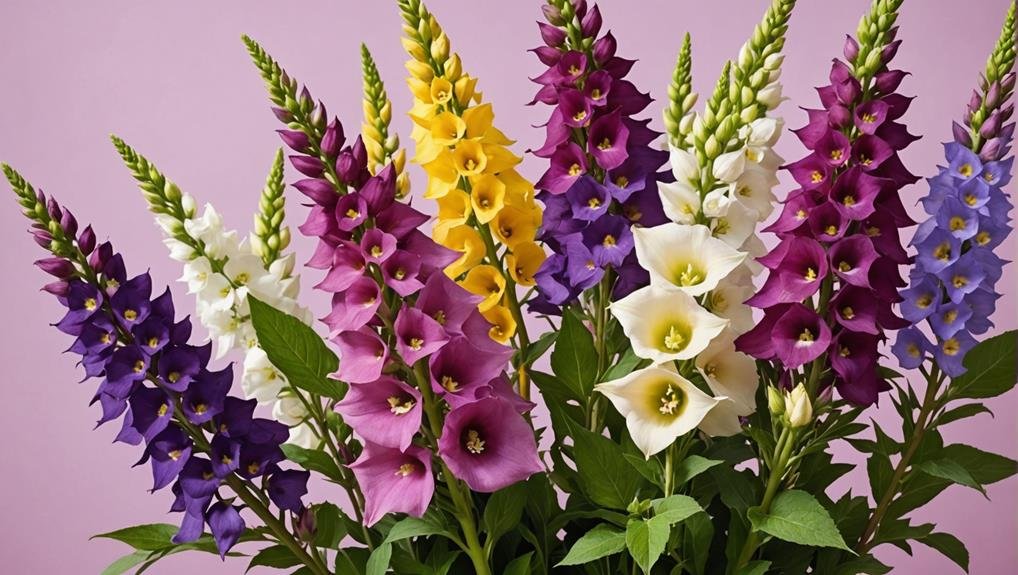
Displaying a captivating array of hues, foxglove flowers are available in shades of pink, cream, peach, and orange. These bell-shaped blooms exhibit an exquisite shift of colors; the outer petals often start as a soft pink and gradually fade into a delightful creamsicle peachy-orange hue. This unique color gradient adds a sophisticated touch to any floral arrangement, making foxglove a popular choice for wedding bouquets.
The versatility of foxglove flowers extends beyond their color palette. Their large bell-shaped blooms create an exotic and eye-catching element within any bouquet. When paired with succulents, pin cushions, roses, and hypericum berries, they form visually stunning compositions that captivate the beholder.
Below is a summary of the available color varieties and their unique features:
| Color | Description | Ideal Pairings |
|---|---|---|
| Pink | Soft, romantic hue | Roses, hypericum berries |
| Cream | Elegant and timeless | Succulents, pin cushions |
| Peach | Warm and inviting | Hypericum berries, roses |
| Orange | Vibrant and exotic | Succulents, pin cushions |
Foxglove illumination flowers are typically sold in bunches of 20, with 5 stems per bunch. This makes them ideal for creating lush and abundant wedding arrangements. Their diverse color options and striking appearance guarantee they remain a cherished choice for brides and florists alike.
Latin Name and Taxonomy
Known scientifically as Digitalis purpurea, this plant belongs to the genus Digitalis and is renowned for its tall spikes of tubular, bell-shaped flowers. As a member of the family Plantaginaceae, foxglove holds a notable place in both horticulture and floristry. Its striking appearance makes it a popular choice for wedding flowers, adding an elegant and distinctive touch to floral arrangements.
The taxonomy of Digitalis purpurea is methodically structured, placing it within the order Lamiales and the class Magnoliopsida. This classification highlights its evolutionary relationships and botanical characteristics, which contribute to its widespread appeal. As a biennial or short-lived perennial, foxglove undergoes a unique lifecycle, blooming in its second year and providing an extended period of visual interest.
Here are some key points about Digitalis purpurea:
- Genus and Species: Digitalis purpurea
- Family: Plantaginaceae
- Order: Lamiales
- Class: Magnoliopsida
Incorporating foxglove into wedding flower arrangements can bring a touch of natural beauty and sophistication. Its tall, graceful spikes and vibrant colors make it an excellent choice for creating memorable and visually stunning wedding bouquets and decorations, ensuring a lasting impression on your special day.
Geographical Origins
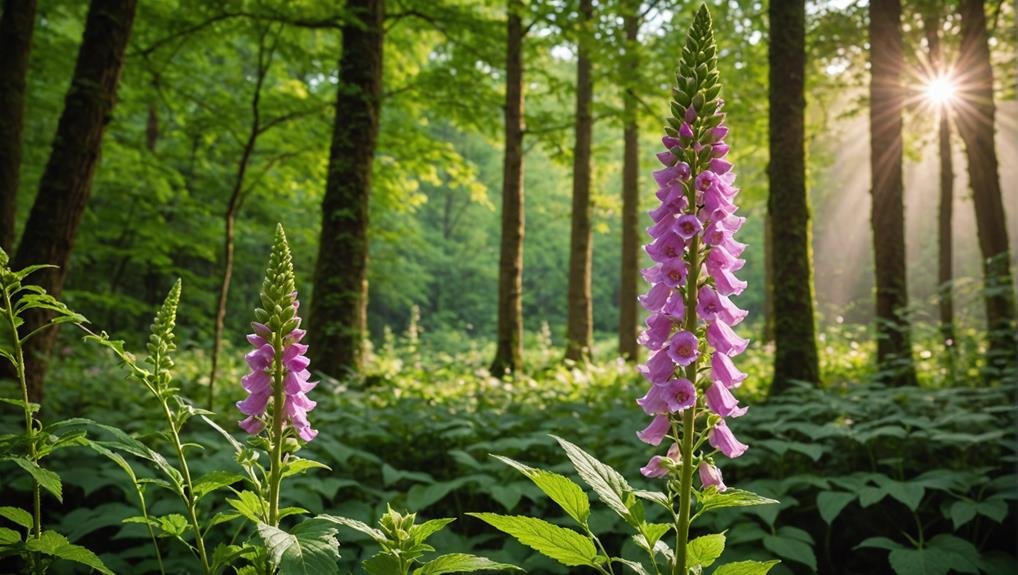
Foxgloves, originating from Europe, the Mediterranean region, and parts of Asia, have a rich history and widespread appeal in various climates and landscapes. These striking plants are primarily native to woodland areas, roadsides, and meadows, where they thrive in partial shade and moist, well-drained soil. Their adaptability to different environments has allowed foxgloves to naturalize in many parts of North America, enhancing their popularity as ornamental plants.
In Europe, foxgloves are often found in diverse habitats, from the cooler climates of northern regions to the warmer Mediterranean landscapes. This geographical diversity has contributed to the plant's resilience and versatility, making it a favored choice for gardeners and landscapers alike. Moreover, the biennial or short-lived perennial nature of foxgloves, producing their impressive flower spikes in the second year of growth, adds to their allure in garden planning and design.
The widespread cultivation of foxgloves is a sign of their aesthetic appeal and adaptability. Whether gracing a woodland garden in Europe or adding a touch of elegance to a wedding bouquet, foxgloves continue to captivate with their towering flower spikes and delicate bell-shaped blooms.
Season Availability
Seasonal availability of foxgloves typically spans from April to June and again in August, providing a window of opportunity for their inclusion in floral arrangements. These periods of availability ensure that foxgloves can be a versatile addition to wedding bouquets, centerpieces, and other decorative elements.
The late summer availability in August is particularly advantageous for couples planning their weddings during this season, as it allows for the inclusion of these elegant blooms when many other flowers may not be in peak season.
Foxgloves are available in bunches, each containing 20 stems, with each stem boasting multiple blooms. This quantity offers ample opportunity for creating lush, full arrangements that can complement a variety of wedding themes and styles.
Here are some key points to keep in mind:
- Vase Life: Foxgloves have a vase life of 5-7 days, making them ideal for short-term use in wedding arrangements.
- Stem Size: Each stem ranges in size from 16-24 inches, providing height and structure to floral designs.
- Bloom Quantity: Each stem features multiple blooms, enhancing the visual appeal and volume of arrangements.
- Pairing Options: Foxgloves pair beautifully with succulents, roses, and hypericum berries for stunning bouquets.
Growing Conditions
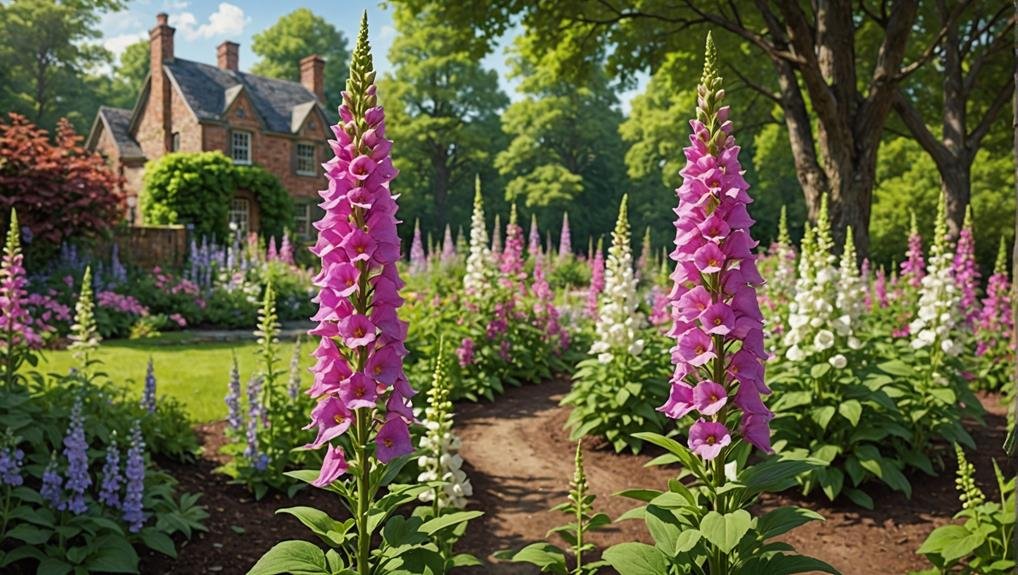
Successfully nurturing foxgloves demands an understanding of their preferred growing conditions, which involve well-draining soil and partial shade. These conditions are essential for guaranteeing that foxgloves reach their full potential, making them an ideal choice for wedding arrangements.
Foxgloves thrive as short-lived biennials, but in cooler regions, they can also flourish as perennials. Regular seeding in August and early spring is recommended to maintain continuous blooming, a significant factor for weddings scheduled throughout the summer.
For those seeking to incorporate foxgloves into wedding floral arrangements, sourcing seeds from reputable suppliers is vital for successful planting. Once the seeds are sown, transplants should be hardened off before being moved outdoors. This acclimatization process helps the plants adjust to their new environment, promoting healthier growth and more vibrant blooms.
Moreover, providing ample moisture and regular foliar feeding ensures that foxgloves continue to bloom throughout the summer. Frequent harvesting of the flowers not only contributes to the plant's health but also ensures a steady supply of blossoms, perfect for creating stunning wedding bouquets and decorations.
With the right growing conditions, foxgloves can be a splendid addition to any wedding setting.
Cultural Significance
The cultural significance of foxgloves is deeply rooted in folklore, historical symbolism, and medicinal applications. These enchanting flowers have woven their way through various aspects of human culture, leaving a lasting impression.
- Folklore and Myths: Foxgloves are often associated with fairies and magical properties. In many tales, they are believed to be the gloves of fairies, lending an air of mystique and enchantment.
- Victorian Symbolism: During the Victorian era, foxgloves symbolized insincerity and false-heartedness. This contradictory nature added to their allure and complexity in historical contexts.
- Medicinal Uses: Known for their potent medicinal properties, foxgloves have been used to treat heart conditions. The plant's scientific name, Digitalis, reflects its significant role in herbal medicine.
- Toxicity: Despite their beauty and medicinal benefits, foxgloves contain toxins such as digitalis glycosides. These compounds can be both therapeutic and deadly, underscoring the plant's dual nature.
The cultural significance of foxgloves encompasses a rich tapestry of beliefs, practices, and historical meanings. Their delicate, finger-like blooms continue to captivate and intrigue, making them a fascinating subject of study and admiration. This complex interplay of folklore, symbolism, and medicinal use highlights the foxglove's enduring presence in various cultural narratives.
Typical Use in Weddings
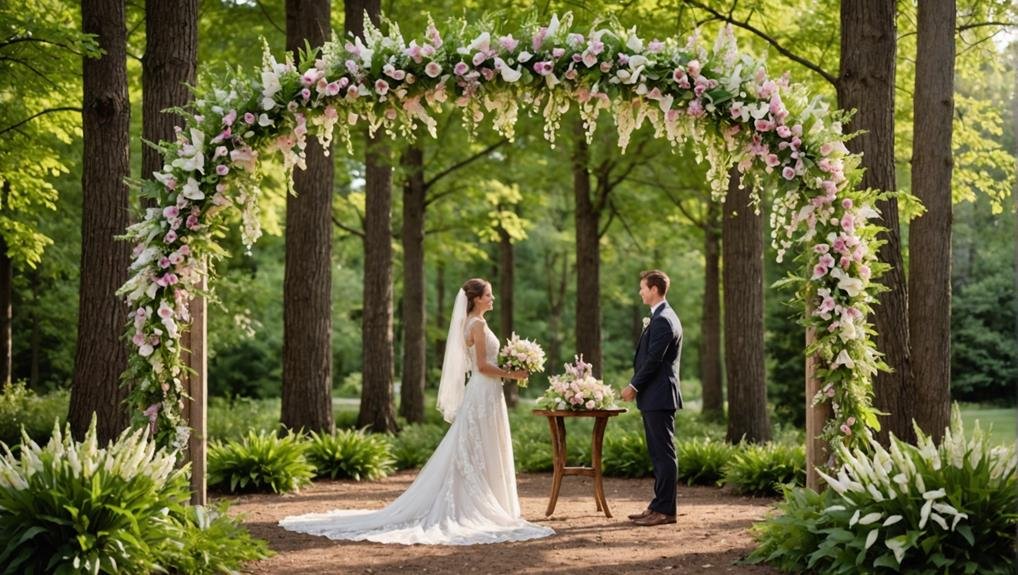
Foxglove flowers, with their exotic appearance and large bell-shaped blooms, are a popular choice for wedding bouquets and floral arrangements. Their unique coloration, featuring pink outer petals that fade into a creamsicle peachy-orange hue, adds a distinctive and elegant touch to wedding floral designs.
Frequently sold in bunches of 20 with 5 stems per bunch, foxglove flowers offer multiple blooms per stem, ranging from 16-24 inches in size, which provides ample material for creating lush and alluring displays.
The vase life of foxglove flowers, typically lasting between 5-7 days, makes them an ideal choice for weddings and other events, ensuring that floral arrangements remain fresh and vibrant throughout the celebrations. These flowers are particularly well-suited for pairing with complementary botanicals such as succulents, pin cushions, roses, and hypericum berries, which enhances their visual appeal and versatility in wedding floral compositions.
Incorporating foxglove flowers into bridal bouquets, table centerpieces, and ceremonial arches can elevate the overall aesthetic of a wedding, bringing a touch of natural beauty and sophistication. Their striking appearance and durable nature make foxglove flowers a preferred selection among florists and brides alike for creating memorable wedding floral arrangements.
Alternative Flower Types
Frequently, couples seek to diversify their wedding floral arrangements by incorporating alternative flower types, which can add unique textures and vibrant colors to their designs. Exploring beyond traditional blooms allows for the creation of visually appealing and fragrant floral compositions that stand out in any wedding setting.
Consider these alternative flower types for your wedding arrangements:
- Turks Cap Lilies: Known for their distinctive shape and vibrant orange color, these lilies are a standout choice, particularly for summer weddings. Their dramatic presence adds a bold statement to bouquets and centerpieces.
- Umbrella Ferns: With their wide-spreading leaves, umbrella ferns can be clipped into smaller sections to add texture and depth. They are perfect for creating lush, layered looks in both bouquets and floral installations.
- Geranium Foliage: Featuring soft textures and varying leaf sizes, geranium foliage works well as a framing agent. Its elegant appearance enhances the overall sophistication of floral arrangements.
- Foxglove: Although not always considered, foxglove can introduce vertical interest and a touch of whimsy to your floral designs, with its tall spikes and bell-shaped blooms.
Incorporating these alternative flowers can transform your wedding floral arrangements, ensuring they are both unique and memorable.
